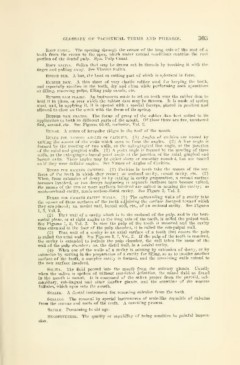Page 561 - My FlipBook
P. 561
GLOSSARY OF TECHNICAL. TEEMS AND PHRASES. 303
Root canal. Th(! oponing through the center of the long axis of the root of a
tooth from the erown to the apex, which under normal conditions contains the root
portion of the dental pulp. Sjn. Pulp Canal.
Ropy saliva. Saliva that may be drawn out in threads by touching it with the
finger and pulling away. See Viscous Saliva.
Round bur. A bur, the head or cutting part of which is spherical in form.
Rubber dam. A thin sheet of very elastic rubber used for keeping the teeth,
and especially cavities in the teeth, dry and clean while performing such operations
as filling, removing pulps, filling pulp canals, etc.
RlTBBER DAM CLAMP. An instrument made to set on teeth over the rubber dam to
hold it in place, or over which the rubber dam may be thrown. It is made of spring
it is opened with a special forceps, placed in position and
steel, and, in applying it,
allowed to close on the tooth with the force of its spring.
Rubber dam grasps. The forms of grasp of the rubber dam best suited to its
application to teeth in different parts of the mouth. Of these there are five, numbered
first, second, etc. See Figures 66-83, inclusive, Vol. 2.
Rugae. A series of irregular ridges in the roof of the mouth.
Rules for naming angles of cavities. (1) Angles of cavities are named by
uniting the names of the walls which meet to fonn the angles. (2) A line angle is
formed by the meeting of two walls, as the axio-gingival line angle, at the junction
of the axial and gingival walls. (3) A point angle is formed by the meeting of three
walls, as the axio-gingivo-bucoal point angle at the junction of the axial, gingival and
buccal walls. These angles may be either sliarp or smoothly rounded, but are named
as if they were definite angles. See Names of Angles of Cavities.
Rules for naming cavities. (1) Cavities in teeth take the names of the sur-
faces of the teeth in which they occur; as occlusal cavity, mesial cavity, etc. (2)
When, from extension of decay or by cutting in cavity preparation, a second surface
becomes involved, or two decays beginning in separate surfaces have become united,
the names of the two or more surfaces involved are united in naming the cavity; as
mesio-occlusal cavity, mesio-occluso-distal cavity. See Figure 3, Vol. 2.
Rules for naming cavity walls. (1) The surrounding walls of a cavity take
the names of those surfaces of the teeth adjoining the surface decayed toward which
they are placed; as, mesial wall, buccal wall, etc., of an occlusal cavity. See Figures
1, 3, Vol. 2.
(2) That wall of a cavity which is to the occlusal of the pulp, and in the hori-
zontal plane, or at right angles to the long axis of the tooth, is called the pulpal wall.
See Figures 1, 3, Vol. 2. In case the pulp of the tooth is removed and the cavity
thus extended to the floor of the pulp chamber, it is called the sub-pulpal wall.
(3) That wall of a cavity iu an axial surface of a tooth that covers the pulp
is called the axial wall. See Figures 3, 7, Vol. 2. If the pulp of the tooth is removed,
the cavity is extended to include the pulp chamber, the wall takes the name of the
wall of the pulp chamber; as, the distal wall, in a mesial cavity.
(4) When one of the waUs of a cavity is missing by extension of decay, or by
extension by cutting in the preparation of a cavity for filling, so as to involve another
surface of the tooth, a complex cavity is formed, and the remaining walls extend to
the new surface involved.
Saliva. The fluid poured into the mouth from the salivary glands. Usually
when the saliva is spoken of without restricted definition, the mixed fluid as found
in the mouth is meant. It is composed of the saliva proper from the parotid, sub-
maxillary, sub-lingual and other smaller glands, and the secretion of the mucous
follicles, which open into the mouth.
Scaler. A dental instrument for removing calculus from the teeth.
Scaling. The removal by special instruments of scale-like depositis of calculus
from the crowns and roots of the teeth. A curetting process.
Senile. Pertaining to old age.
Sensitiveness. The quality or capability of being sensitive to painful impres-
sion.


